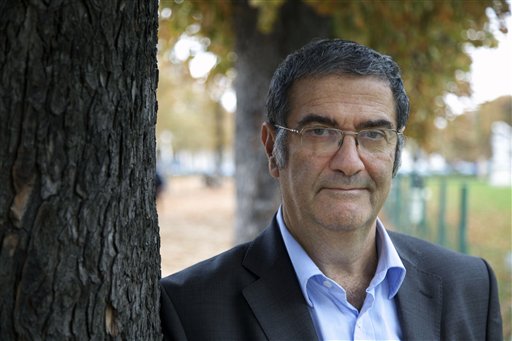(AP) Frenchman, American win Nobel for quantum physics
By KARL RITTER and LOUISE NORDSTROM
Associated Press
STOCKHOLM
A French-American duo shared the 2012 Nobel Prize in physics Tuesday for inventing methods to observe the bizarre properties of the quantum world, research that has led to the construction of extremely precise clocks and helped scientists take the first steps toward building superfast computers.
Serge Haroche of France and American David Wineland opened the door to new experiments in quantum physics by showing how to observe individual quantum particles while preserving their quantum properties.
A quantum particle is one that is isolated from everything else. In this situation, an atom or electron or photon takes on strange properties. It can be in two places at once, for example. It behaves in some ways like a wave. But these properties are instantly changed when it interacts with something else, such as when somebody observes it.
Working separately, the two scientists, both 68, developed “ingenious laboratory methods” that allowed them to manage and measure and control fragile quantum states, the Royal Swedish Academy of Sciences said.
Haroche is a professor at the College de France and Ecole Normale Superieure in Paris. Wineland is a physicist at the National Institute of Standards and Technology and the University of Colorado in Boulder, Colorado.
The two researchers use opposite approaches to examine, control and count quantum particles, the academy said.
Wineland traps ions _ electrically charged atoms _ and measures them with light, while Haroche controls and measures photons, or light particles.
Haroche said he was out walking with his wife when he got the call from the Nobel judges.
He said his work in the realm of quantum physics could ultimately lead to unimaginably fast computers.
Haroche also said quantum research could help make GPS navigating systems more accurate.
Christopher Monroe, who does similar work at the Joint Quantum Institute at the University of Maryland, said the awarding of the prize to the two men “is not a big surprise to me … It was sort of obvious that they were a package.”
Monroe said that thanks to the bizarre properties of the quantum world, when he and Wineland worked together in the 1990s, they were able to put a single atom in two places simultaneously.
At that time, it wasn’t clear that trapping single atoms could help pave the way to superfast quantum computers, he said. That whole field “just fell into our laps,'” Monroe said.
In an ordinary computer, information is represented in bits, each of which is either a zero or a one. But in a quantum computer, an individual particle can essentially represent a zero and a one at the same time. If scientists can make such particles work together, certain kinds of calculations could be done with blazing speed.
One example is the factoring, the process of discovering what numbers can be multiplied together to produce a given number. That has implications for breaking codes, Monroe said.
Quantum computers could radically change people’s lives in the way that classical computers did last century, but a full-scale quantum computer is still decades away, the Nobel judges said.
The physics prize was the second of the 2012 Nobel Prizes to be announced, with the medicine award going Monday to stem cell pioneers John Gurdon of Britain and Japan’s Shinya Yamanaka. Each award is worth 8 million kronor, or about $1.2 million.
Only two women have won the physics prize since it was first awarded in 1901: Marie Curie in 1903 and Maria Goeppert-Mayer in 1963.
The prizes are always handed out on Dec. 10, the anniversary of prize founder Alfred Nobel’s death in 1896.
___
AP science writer Malcolm Ritter in New York and Lori Hinnant in Paris contributed to this report.

COMMENTS
Please let us know if you're having issues with commenting.